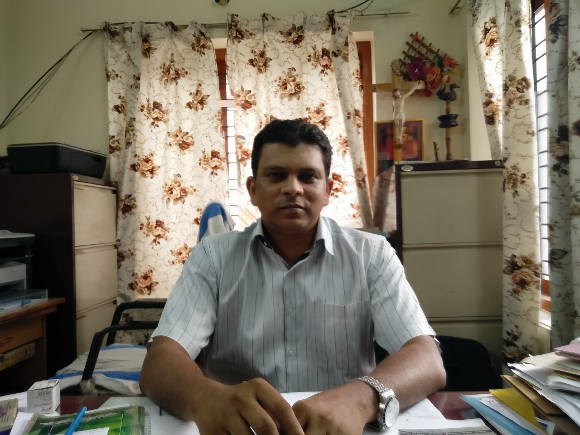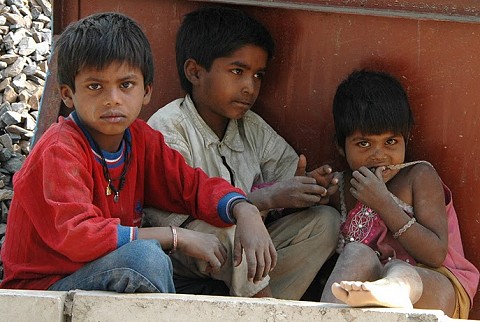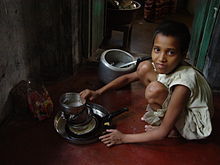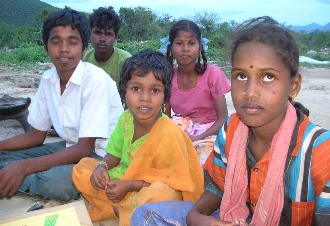Sara*, a 17-year-old domestic worker from Karnataka, died at her employer’s house in Kannur district last August. Her post mortem report says that her stomach was half full of a liquid (which the doctor suspects to be a toilet cleaning liquid), and that her hymen had been lost earlier. The stomach content was sent for chemical analysis to the neighbouring district; but four months later, the chemical report has not arrived, and hardly any investigation has happened in the case. Only a charge of bonded labour has been made out against Sara’s employers.
Jayaraj M P, sub-judge and Secretary of the District Legal Services Authority (DLSA), says that the case clearly points to either murder or abetment to suicide, and also sexual assault. Jayaraj had got involved with child labour cases last year, when an activist group approached him pointing to poor investigation in the cases. Last April, he had also submitted an inquiry report on child labour in the district, based on directions of the state Legal Services Authority. The report’s findings are that domestic child labour – including forced labour and physical harassment – exists here, and that there is prima facie evidence of child trafficking.
In Sara’s case, there are contradicting statements from policemen themselves. Sub-inspector Biju M V, who newly took charge of the case, says that major charges can be made against the employers only once the chemical report reveals what the stomach content was. The lab has said that the report would take another month, he says.
But Deputy Superintendent of Police V N Vishwanath, who is also district nodal officer for anti-human trafficking, says that the chemical report would not reveal much. “The doctor who did the post mortem has already said that it was likely a toilet cleaning liquid. He said there was no sign of forced feeding of the liquid, so it can’t be murder.”
When asked whether the child could have committed suicide due to employer’s harassment, Vishwanath says that the accused cannot be charged on this count just because they employed the girl. He says that suicide was also unlikely as it would have been difficult for the girl to swallow cleaning liquid directly.
If it was neither murder nor suicide, then how did the liquid ended up in Sara’s stomach? Jayaraj says, “It’s true that charges of murder or abetment to suicide cannot be made without an investigation. But why should the police wait for a chemical report to start investigation?”
The doctor who did the post mortem had suggested that Sara’s hymen could have been lost due to natural reasons. But Jayaraj says that complete loss – as opposed to tear – of hymen in a young girl due to natural reasons is very unlikely. Jayaraj says that despite his repeated requests to Kolavalloor police station, they did not send him a copy of the post mortem report, and that he finally had to get it through unofficial channels.
In some districts, police raids in association with Childline or Child Welfare Committee (CWC) have reduced child labour cases.
But many instances of police’s callousness or complicity with employers are reported by activists across Kerala. Also, the government policy is to send the rescued migrant children back to their home states as soon as possible. Once the children go back, cases often turn cold as no one keeps track of these cases.
The State Crime Records Bureau (SCRB) declined to share data on police cases of child labour, stating that it is restricted under RTI Act.
Fake IDs, lack of evidence
Identifying a child labour case itself is difficult as there is usually no proof of the child’s age or employment. Childline officials say that when they go to workplaces based on tip-offs, the child may be removed from the workplace, or employers say he is only accompanying a family member or observing work. Sometimes children themselves don’t admit that they work, as they also feel the need to earn.
Getting a proof of age is difficult since migrant child labourers mostly do not carry valid ID cards. Most ID cards are fake; some are merely cards mentioning age of the person and sealed by a village panchayat. Sometimes parents who come to claim children also give fake proof.
One such instance was at Trivandrum Childline, where the child was rescued from work on a Saturday evening, and his relatives came to claim him on Sunday, showing his school’s Transfer Certificate (TC); but the TC carried the date of Sunday. A P Jobi, Childline coordinator at Trivandrum says, “There is no modern, reliable system to verify ID cards. We may know that the child is young on seeing him, but proving this is difficult.”
In all child labour cases, the children are referred to the CWC. CWC can refer the child for a medical exam to determine age. But these exams need not give accurate results; sometimes the age range given is very wide.
Nirish Antony, coordinator of Childline Ernakulam cites a case where three designated doctors gave three different opinions on age of the child. “The child seemed to be around 14 years. Tests were done by a dentist, neurologist and radiologist - one gave the age range as 13-15 years, while another gave age range close to 20 years. The final average age they gave was 16-20 years, and the child was sent back,” he says.
Cases of children aged 14-18 years are even more complicated. Child Labour Act, 1986 places conditions for their work (hours of work, rest etc), and prohibits some hazardous jobs. But in practice, Labour Department registers cases only if the child is below 14 years.
“If we say that the child is above 14, labour officers do not come at all,” says Jobi. In cases of children aged 14-18 years, if there is physical or economic exploitation at work, police can file cases as per Juvenile Justice (JJ) Act. But exploitation is difficult to prove.

Fr Thomas P D, coordinator at Trivandrum Childline, says it is difficult to find proof in cases where adolescents are exploited at work. Pic: Navya PK
“No one monitors children’s work conditions. Also, there is no clarity in Child Labour Act on what exactly counts as rest hour etc.,” says another Trivandrum Childline coordinator Fr Thomas P D.
Police can also file cases of trafficking, as per IPC Section 370 introduced in 2013. But this section is often not applied.
An example is the case of 13-year-old Amina* from Andhra Pradesh, who was rescued from a house in Kannur district in August 2015. Police filed only a case of child labour, and not of trafficking.
The FIR was filed only after public protests, says E Maneesh, Secretary of the local activist group Janakeeya Vedi. After Maneesh impleaded himself into the case, first the High Court and later magistrate court ordered the police to investigate trafficking in the case. The magistrate court passed its order last June, after going through the police case diary and finding that trafficking had not been investigated. But even now, around one and half years after the FIR was filed, there are no findings. Sub-inspector K V Nishith says that the police had gone to Andhra Pradesh recently, but could not find proof of trafficking.
In Thrissur, a trafficking case was dismissed in court because of poor police investigation, says Thrissur CWC Chairman P O George. Seven boys had been trafficked to work in a Pantaloons showroom by a registered labour contractor from a neighbouring district. The children’s Aadhar cards showed them to be above 20 years. “But they seemed to be below or around 14 years only, which was confirmed by their medical exams. Police did not investigate, and in court they said there was no proof that the Aadhar cards were fake,” says George.
In Jayaraj’s inquiry report, there are many instances where employers were unable to clarify how they got the child worker. This includes one case of an employer claiming that he got a 15-year-old domestic worker personally, from the child’s father in Jharkhand. But he was unable to give the child’s address, father’s name or even the location where they met. “Parents in far-off states won’t know about job opportunities in villages in Kerala unless there is an agent,” says Jayaraj.
Many cases of trafficking, but no findings
S Sreejith, Inspector General of Ernakulam Range, and Assistant Nodal Officer, Anti-Human Trafficking Cell, Kerala Police, says there are many cases of children being trafficked to Kerala for work. He says that lack of awareness amongst the police is a problem. “Many policemen think that children can at least make some money if someone brings them to work here. They don’t realise that the child is being exploited. This is more so in cases of 14-18 year old children. We see this attitude in courts also – traffickers get bail very quickly,” he says.
Sreejith says that about 16 trafficking cases related to child labour have been registered in the state since 2013, but a clear picture of who the traffickers are and how they operate has not emerged yet. In Ernakulam district, police has rescued many children from plywood factories and other workplaces. Children even below 14 years were found to be beaten up and forced to work in hazardous conditions in plywood factories.
But in many cases, the victims – who are the primary witnesses in the case – turn hostile or go back to the traffickers, says Sreejith. “Rescued children are put in children’s homes which are overcrowded, without facilities or good counsellors. Counsellors should be able to help the child speak up, and ensure that the child is not exposed to traffickers or to the investigating officers unnecessarily. The child may also face further abuse in these homes, and would prefer to go back to the trafficker,” he says. The children are usually sent to government children’s homes; but if these are crowded, to NGO-run homes.
In the case of a lawyer who trafficked children from across Kerala promising free football training and food, the police applied trafficking section. The lawyer was found to have made the children work, harass them physically and mentally, and denied them proper food and facilities. Sreejith says that except two, all children turned hostile in this case. The lawyer got bail from lower court and has approached High Court asking that the FIR be quashed.
In cases of migrant children, once the children are sent back, there is no follow-up on what happens to them. Sreejith says that these children are likely to go back to work, as trafficking had occurred with their parents’ consent itself. Tracking down the children becomes difficult once they go back.
Sreejith narrates the case of 16 children from Lohit district in Arunachal Pradesh, who were rescued from a plywood factory in Kuruppampady town in Ernakulam. “When I enquired, I found that the SI in his case file wrote exactly what the children told him - that they had known about the jobs from an acquaintance who worked here. It’s as if the children woke up one day thinking that Kuruppampady is their utopia, boarded a train, walked straight into the factory and started working there,” he says. The children have gone back to Lohit.
Sreejith says that in 2011-12, 1256 children - both locals and migrants - were rescued in the state overall, in various cases, “Some 245 FIRs were registered, under JJ Act. Trafficking was also registered under JJ Act then, as IPC section on trafficking did not exist. None of these cases stand today.” He says that providing at least good short stay homes, and good counsellors, is the solution; and that Social Justice Department should provide this infrastructure.
Surendrakumar K K, Joint Director (General) at Social Justice Department, says that there have been complaints about lack of counsellors in government homes. “Data on total number of counsellors in these homes is not available; we are trying to compile it. There are 32 government homes in the state. In some homes there may be two counsellors while in some others there may be only one counsellor who visits 1-2 times a week.” For example, Trivandrum district has only two counsellors for three homes; and Kollam district has only one counsellor for two homes.
George says that lack of Special Juvenile Police Units (SJPUs) is a major reason why child labour cases are not investigated seriously. As per JJ Act, all districts should have SJPUs with trained officers who should register and investigate such cases. But there is only one SJPU in all of Kerala. In all other police stations, the Station House Officer (SHO) has been designated as Special Juvenile Police. George says, “SHOs already have 101 responsibilities, and cannot handle these cases too. So any police officer, who need not be committed to such cases, will be allowed to handle these.”
Denial by the Labour Department
While the state police is accused of poor investigation, the state Labour Department has largely denied that child labour cases exist at all. Labour Department is primarily responsible for enforcing Child Labour Act. The department’s data shows that in 2015 they had filed only four cases of child labour, and in 2014 only one case.
Alexander A, Joint Director (Enforcement) at the state Labour Department, says that though children are used for domestic work, it’s not possible to inspect houses directly. “Sometimes migrant children help their families working in brick kilns or laying cables. But we cannot file cases against the employers as they did not employ the children directly,” he says.
Though Child Labour Act has provisions for imprisoning employers, usually only fines are levied, says Alexander. “Child Labour Act is a social legislation. So as per convention, the smallest penalty is levied,” he says.
The amended Child Labour Act, 2016, allows employment of children below 14 years in family enterprises. This affects prosecution of cases when parents claim that the employers are their relatives, says an Assistant Labour Officer, on condition of anonymity. “This happened in three cases of domestic labour I found in Ernakulam district. The parents were very poor, and the employers affluent,” says the officer.

K G Valsala Kumar, District Labour Officer (Enforcement) at Trivandrum, says that poor facilities at the department and difficulty in finding evidences dissuades officers from filing cases. “Officers need vehicles for inspections. But the department has only one vehicle per district, and that too very old ones which can’t climb hilly areas. Three districts have no vehicles at all. As Labour Department does not generate revenue, it gets low priority.” He says that cases also get dismissed in court if evidence is not strong. “Since fines in these cases are relatively high, employers challenge these in court.”
As per a Supreme Court verdict of 1996 in M C Mehta vs State of Tamil Nadu, employers who used child labourers should pay Rs 20,000 to a ‘Child labour rehabilitation-cum-welfare fund’. But Kumar says that courts levy lower fines, and that rehabilitation-cum-welfare committees in all the districts are dysfunctional. The committee includes members of Labour Department. Earlier, the minimum fine for employers as per Child Labour Act was Rs 10,000. The recent amendment has increased this to Rs 20,000. But whether Labour Department will file more cases, remains to be seen.
*Names have been changed to protect identities.


























